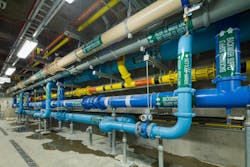The Rueter-Hess Water Purification Facility (RHWPF) in Parker, Colo., was honored with a national award from the American Academy of Environmental Engineers and Scientists (AAEES). The 2016 Excellence in Environmental Engineering Award recognizes RHWPF’s technology and use of a renewable water supply.
The water treatment plant serves a community of approximately 50,000 residents in a 43-sq-mile area southeast of Denver. The $51.5 million plant uses new technologies that have enabled the Parker Water and Sanitation District (PWSD) to convert their sources from the rapidly declining groundwater supply to a renewable water supply, including surface water, groundwater, alluvial well water and reclaimed wastewater.
Designed by Dewberry, the RHWPF is the first plant to incorporate a trio of sequential technologies to meet U.S. Environmental Protection Agency (EPA) drinking water standards. The facility opened last year.
The technologies include:
- Ballasted sedimentation – A coagulation, flocculation and sedimentation chamber uses microsand to enhance particle sedimentation while reducing the chamber’s surface area requirements.
- Recirculated PAC – A recirculating powdered activated carbon (PAC) chamber cuts costs by sending used PAC back through the system, thus increasing the amount of contact time between PAC particles and dissolved organic compounds for a more aggressive and efficient treatment.
- Ceramic membrane filtration – The treated water is pumped through ceramic membrane filters to remove remaining particles larger than 0.1 microns in size and any remaining microsand or PAC.
In the application, the ceramic membrane filtration system can withstand impacts from the abrasive sand and PAC particles used in upstream processes. After cleaning, it returns to like-new condition. The system is anticipated to withstand repeated aggressive cleaning cycles.
The completion of the 10-MGD RHWPF, which is incrementally expandable to 40 MGD, is part of a multi-phase plan for the water district. The new network features a 50-CFS pump station that brings surface water from nearby Cherry Creek and Cherry Creek alluvial wells into the 72,000-acre-ft Rueter-Hess Reservoir, which was completed in 2012. Water stored in the reservoir flows by gravity into the RHWPF.
After moving through the two ballasted sedimentation chambers and the ceramic membrane filters, the disinfected water is pumped into the PWSD’s distribution piping network for use by customers. Wastewater is returned to nearby reclamation facilities and then to Cherry Creek for reuse.
Because the pioneering design of the RHWPF systems enables shorter water detention times, a smaller building footprint was required. The treatment facility is housed within an enclosed, 33,000-sq-ft building, providing year-round weather protection for the plant. The building can be expanded to 65,000 sq ft.
In addition to Dewberry, the project team included Western Summit Constructors Inc. as the primary contractor, Garney-Weaver for construction management, and Kruger Inc. for the ballasted sedimentation and ceramic membrane filter technologies. Lintjer + Haywood Architects provided architecture for the facility, Integrated Solutions Engineering provided electrical engineering, and Shaffer Baucom Engineering & Consulting provided HVAC and plumbing engineering. Norris Design provided landscape and irrigation design.
Source: Dewberry


